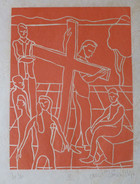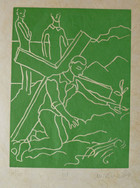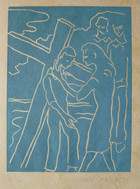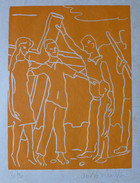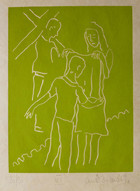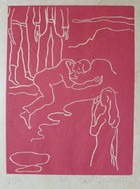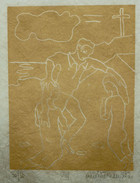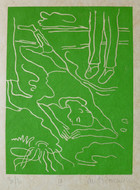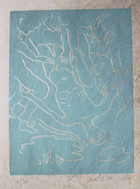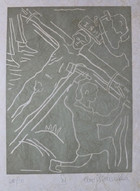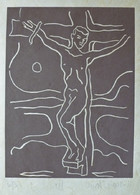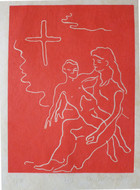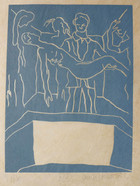Adrian Wiszniewski
To mark the new millennium and two thousand years of Christianity, the Anglican diocese of St. Edmundsbury and Ipswich in Suffolk, England, worked together with the St. Edmunds Art Gallery to realize an unusual, cutting-edge sacred art project. They commissioned thirteen established, figurative and abstract painters and sculptors to create contemporary versions of traditional Stations of the Cross imagery to be displayed in churches throughout Suffolk in the year 2000. Scottish Artist Adrian Wiszniewski’s contribution to Stations: the New Sacred Art was a suite of linocut prints of the Passion of Christ, now in the Sacred Art Pilgrim Collection, for the 14th century St. Andrew's Church in the village of Wingfield.
Known for his “fearless versatility," Wisniewski has done everything from designing parking garages and creating neon installations to writing novels and staging multi-media events. The millennial sacred art project is not the artist's first or last experience with church commissions. He had already painted two canvases in 1995-1996 for the Anglican Cathedral in Liverpool of The Good Samaritan, played out in the contemporary youth scene, and The House Built on Rock, showing a family making sand castles on a beach. In 2011, the Church of Scotland Fairmilehead Parish Church in Edinburgh unveiled a new Wiszniewski painting, depicting the Abundant Life promised by Christ in John 10:10, featuring picnickers, cyclists, and “the dance of life.
Like Scottish-based Artist Peter Howson, Wiszniewski is identified with the “New Glasgow Boys,” a loose grouping of artists at the Glasgow School of Arts in the 1980s, who challenged prevailing abstract, conceptualist trends with figurative, narrative-oriented art. Wiszniewski’s style is markedly different from the darkly baroque, angst-filled works of Howson with their exaggeratedly muscled figures in apocalyptic settings. He most typically presents idealized youths, who are languidly posed in kaleidoscopic-colored landscapes full of symbolic objects. They take part in stories of ambigious meaning, as if moving through surreal, dream spaces. Wiszniewski is often compared to 19th century British Romantics like William Blake and Samuel Palmer.
The linocut Stations of the Cross series in the image gallery offers an intriguing variation of the quintessential Wiszniewski style. Each of the prints is a single color, resulting in a combined palette of 14 different hues. This is the Passion Play, as enacted by a British public school drama club, where youthful bystanders in suit jackets and neatly pressed trousers follow Christ along the Way of Sorrow. The Savior of the World looks like an awkward adolescent, when he confronts his mother, Mary, in Station IV. She, in turn, cradles the body of a Man-Child in her lap, when Jesus is taken down from the Cross in Station XIII. In a lyrical moment in Station III, the fallen, boyish Christ reaches out to touch a plant by the roadside. For all the naive simplicity of these spare lined prints, there is a disturbing feeling we are revisiting Lord of the Flies country.

